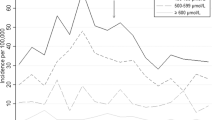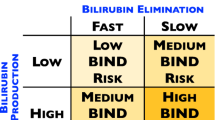Abstract
Objective:
The purpose of this study was to analyze a targeted screening program for glucose-6-phosphate dehydrogenase (G6PD) deficiency (G6PDdef) and clinical outcomes of G6PD-deficient vs G6PD normal newborns.
Study Design:
Retrospective chart review for 1578 male newborns was performed. The study group was those screened for G6PDdef. Comparisons between G6PD-deficient and normal infants were made with χ2-test and unpaired t-test.
Result:
A total of 1095 male newborns were screened, 11.1% had G6PDdef. 97.8% of screen results were reported by 48 h. Total bilirubin (TB) levels in deficient infants were significantly higher than in normal infants throughout birth hospitalization and they were more likely to receive phototherapy. Nineteen screened newborns were rehospitalized for hyperbilirubinemia, 47% had G6PDdef.
Conclusion:
In-hospital newborn screening for G6PDdef with rapid turnaround time is possible. G6PDdef is a risk factor for hyperbilirubinemia in American newborns. US centers with large at-risk populations can identify newborns at risk for severe hyperbilirubinemia with similar screening.
This is a preview of subscription content, access via your institution
Access options
Subscribe to this journal
Receive 12 print issues and online access
$259.00 per year
only $21.58 per issue
Buy this article
- Purchase on Springer Link
- Instant access to full article PDF
Prices may be subject to local taxes which are calculated during checkout


Similar content being viewed by others
References
Cappellini MD, Fiorelli G . Glucose-6-phosphate dehydrogenase deficiency. Lancet 2008; 371: 64–74.
WHO Working Group. Glucose-6-phosphate dehydrogenase deficiency. Bull World Health Org 1989; 67: 601–611.
Beutler E . Glucose-6-phosphate dehydrogenase deficiency: a historical perspective. Blood 2008; 111 (1): 16–24.
Sgro M, Campbell D, Shah V . Incidence and causes of severe neonatal hyperbilirubinemia in Canada. CMAJ 2006; 175 (6): 587–590.
Manning D, Todd P, Maxwell M, Platt MJ . Prospective surveillance study of severe hyperbilirubinaemia in the newborn in the UK and Ireland. Arch Dis Child Fetal Neonatal Ed 2007; 92: 342–346.
Bhutani VK, Johnson LH, Maisels MJ, Newman TB, Phibbs C, Stark AR et al. Kernicterus: epidemiological strategies for its prevention through systems-based approaches. J Perinatol 2004; 24: 650–662.
Kaplan M, Hammerman C . Glucose-6-phosphate dehydrogenase-deficient neonates: a potential cause for concern in North America. Pediatrics 2000; 106 (6): 1478–1480.
Kaplan M, Hammerman C . The need for neonatal glucose-6-phosphate dehydrogenase screening: a global perspective. J Perinatol 2009; 29: S46–S52.
Bhutani VK, Johnson LH, Sivieri EM . Predictive ability of a predischarge hour-specific serum bilirubin for subsequent significant hyperbilirubinemia in healthy term and near-term newborns. Pediatrics 1999; 103: 6–14.
American Academy of Pediatrics Subcommittee on Hyperbilirubinemia. Clinical practice guideline: management of hyperbilirubinemia in the newborn infant 35 or more weeks of gestation. Pediatrics 2004; 114 (1): 297–316.
Beutler E . G6PD deficiency. Blood 1994; 84 (11): 3613–3636.
Kaplan M, Herschel M, Hammerman C, Hoyer JD, Heller GZ, Stevenson DK . Neonatal hyperbilirubinemia in African American males: the importance of glucose-6-phophate dehydrogenase deficiency. J Pediatr 2006; 149: 83–88.
Maisels MJ, Newman TB . Jaundice in full-term and near-term babies who leave the hospital within 36 h. Clin Perinatol 1998; 25: 295–302.
Kaplan M, Leiter C, Hammerman C, Rudensky B . Comparison of commercial screening tests for glucose-6-phosphate dehydrogenase deficiency in the newborn period. Clin Chem 1997; 43: 1236–1237.
Ainoon O, Alawiyah A, Yu YH, Cheong SK, Hamidah NH, Boo NY et al. Semiquantitative screening test for G6PD deficiency detects severe deficiency but misses a substantial proportion of partial-deficiency females. Southeast Asian J Trop Med Public Health 2003; 34 (2): 405–414.
Kaplan M, Beutler E, Vreman HJ, Hammerman C, Levy-Lahad E, Renbaum P et al. Neonatal hyperbilirubinemia in glucose-6-phosphate deydrogenase-deficient heterozygotes. Pediatrics 1999; 104: 68–74.
Wong FL, Boo NY, Ainoon O, Wang MK . Comparison of detection of glucose-6-phosphate dehydrogenase deficiency using fluorescent spot test, enzyme assay and molecular method for prediction of severe neonatal hyperbilirubinemia. Singapore Med J 2009; 50 (1): 62–67.
Raju TN . Epidemiology of late preterm (near-term) births. Clin Perinatol 2006; 33 (4): 751–763.
Davidoff MJ, Dias T, Damus K, Russell R, Bettegowda VR, Dolan S et al. Changes in the gestational age distribution among U.S. singleton births: impact on rates of late preterm birth, 1992 to 2002. Semin Perinatol 2006; 30 (1): 8–15.
Kaplan M, Muraca M, Vreman HJ, Hammerman C, Vilei MT, Rubaltelli FF et al. Neonatal bilirubin production-conjugation imbalance: effect of glucose-6-phosphate dehydrogenase deficiency and borderline prematurity. Arch Dis Child Fetal Neonatal Ed 2005; 90: F123–F127.
JCAHO. Revised guidance to help prevent kernicterus. Sentinal Event Alert 2004; (31): 1–2.
Author information
Authors and Affiliations
Corresponding author
Ethics declarations
Competing interests
The authors declare no conflict of interest.
Rights and permissions
About this article
Cite this article
Nock, M., Johnson, E., Krugman, R. et al. Implementation and analysis of a pilot in-hospital newborn screening program for glucose-6-phosphate dehydrogenase deficiency in the United States. J Perinatol 31, 112–117 (2011). https://doi.org/10.1038/jp.2010.69
Received:
Revised:
Accepted:
Published:
Issue Date:
DOI: https://doi.org/10.1038/jp.2010.69
Keywords
This article is cited by
-
The African-American neonate at risk for extreme hyperbilirubinemia: a better management strategy is needed
Journal of Perinatology (2017)
-
Extreme hyperbilirubinemia and rescue exchange transfusion in California from 2007 to 2012
Journal of Perinatology (2016)
-
Parental education and the WHO neonatal G-6-PD screening program: a quarter century later
Journal of Perinatology (2015)
-
Assessment of G6PD screening program in premature infants in a NICU
Journal of Perinatology (2015)
-
Should we screen newborns for glucose-6-phosphate dehydrogenase deficiency in the United States?
Journal of Perinatology (2013)



